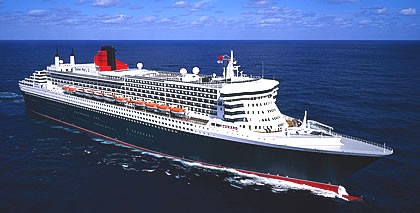"Cruise" Ships and "Liners"
Let’s first make clear the difference between a cruise and a crossing. "Cruises" include stops in a number of ports, sometimes almost daily. Some people express their preference for the stops, complaining that if a “at sea” day interrupts that shore routine, there’s nothing to do. Of course, some ships do offer precious little to do on "at sea days", but they are, fortunately, few and far between. In any case, on a "cruise" you divide your time between two experiences: visiting ports and enjoying life on board.
A "Crossing" is different in that there are no stops. For example, the Liner Queen Mary 2 connects Southampton and New York in six days. The occasional other ship doing a Transatlantic Crossing might connect other ports in a similar time frame. In any case this sort of trip consists of nothing other than "at sea days", and one’s whole concentration is centered on life on board. How boring can that be? Not in the slightest. As a matter of fact, there’s not enough time to do everything you’d like.
On the world cruises, people can embark in Southampton and disembark in Southampton. They don’t ever have to leave the ship. Some don’t. The ship is the adventure in itself. Being on board becomes all the fun. Apparently, one woman still lives on the QE2 after 14 years. You can imagine the life style spent constantly traveling the world, visiting whichever ports you want and ignoring the rest. I've even seen a cost comparison between the price of living onboard a Cruise Ship with its all the amenities-- Doctors etc. and the price of living in an upscale retirement home here on land. The Cruise Ship looks pretty good! I know where I would prefer to live out my "Golden Years"!!!!
Let’s say a ship makes regularly scheduled trips between New York and Southampton. This is a “crossing” and the ship is then called a “Liner”. Draw a line between point A and point B. A line goes between two points. The true liners, such as the Queen Mary 2 and the Queen Elizabeth were expressly designed and built to go between England and America. A "liner" is designed to be a ship that can handle the possibility of serious weather on the North Atlantic. It tends to be constructed with thicker steel for the hull and has fewer -- if any -- balcony suites as there is precious little to see on a "crossing". It also tends to have a more prominent bow to withstand heavier seas. The Public Rooms on board tend to be opulent and designed to entertain the passengers for the six or so days they are on board.
Queen Mary 2
Given the market today, some of the liners will do double service as a liner and a cruiser but this is not common. Last year, the Queen Victoria, cruised around the world, going west, the long way around, from New York to Southampton, which took about 90 days. This is a one-time trip. It’s a cruise, stopping at many ports along the way. In this instance, the ship is not a liner. It’s a cruise ship.
A Cruise Ship lost its long bows and began to look more like what they are, floating hotels, with balconies for nearly everyone as there is so much for the passengers to watch as they sail between famous ports enjoying the always calm seas and beautiful weather. “Getting there is half the fun.” is the current Motto of one of the largest Cruise Ship Companies. Crammed full of swimming pools, bars, climbing walls etc, the passengers are constantly entertained so the dreaded "days at sea" pass easily.
The Diamond Princess
This change, from transatlantic liners to cruisers, changed the mix of passengers, from business people and professionals going between New York and Southampton as a means of opulent transportation, to something to do for the well-heeled elderly and an escape from the workplace for younger people who could spend a week or two drinking Margaritas and watching beautiful sunsets and sunrises, only going to shore if they pleased.
Had it not been for the successful transition from transatlantic ships for the very rich to cruise ships for the common man, there would be no passenger ships on the seas today.
RETURN TO EPISTLE

